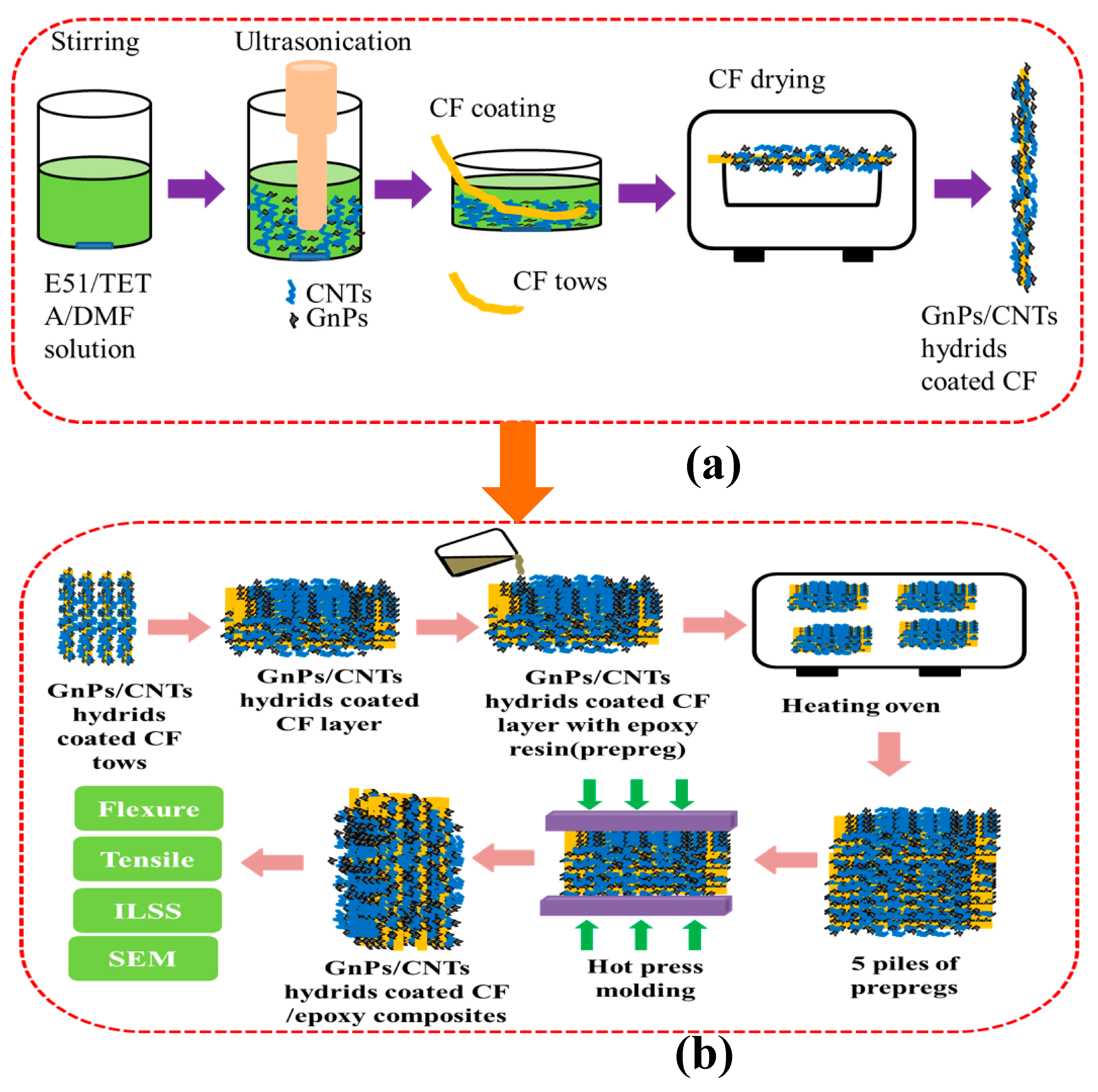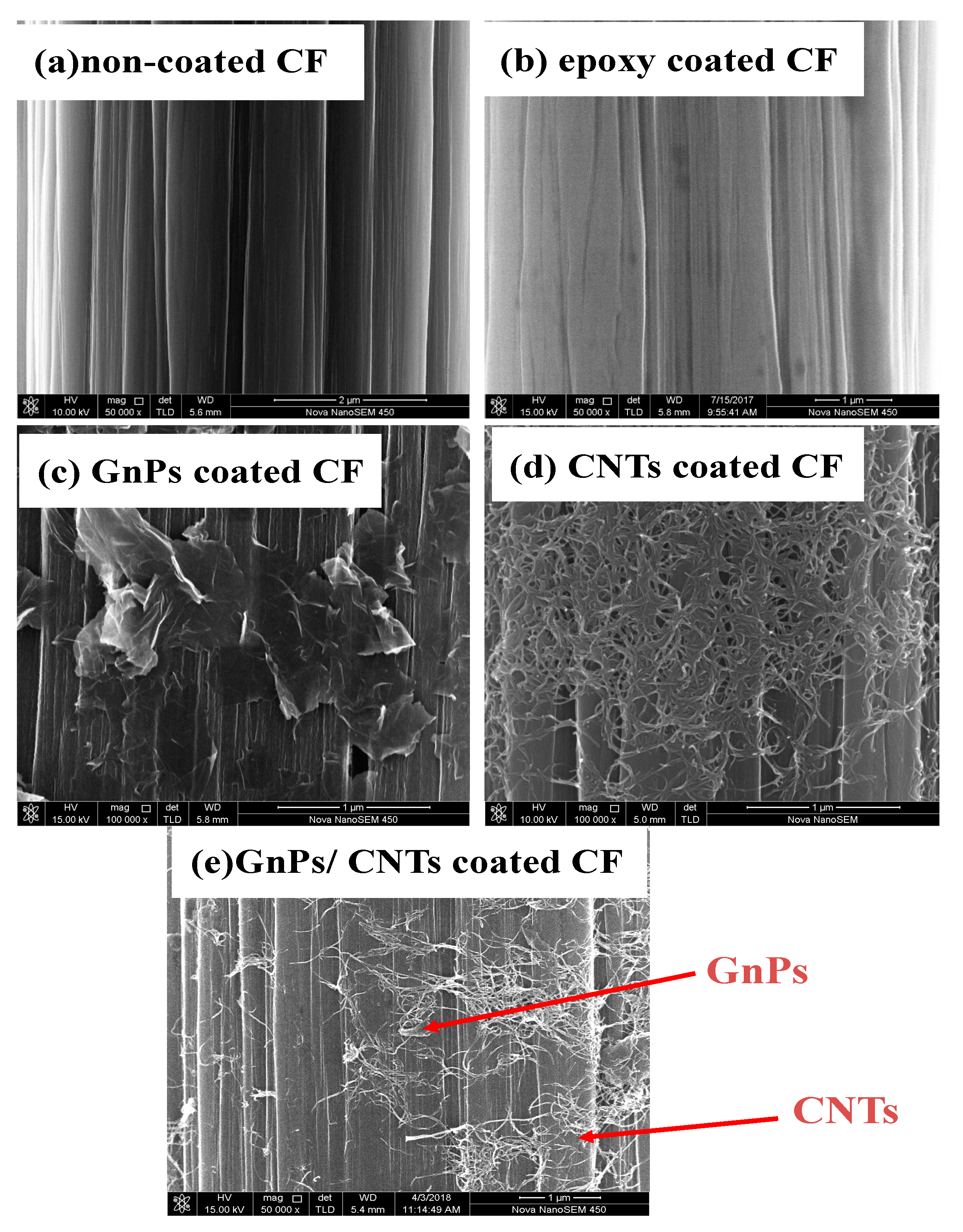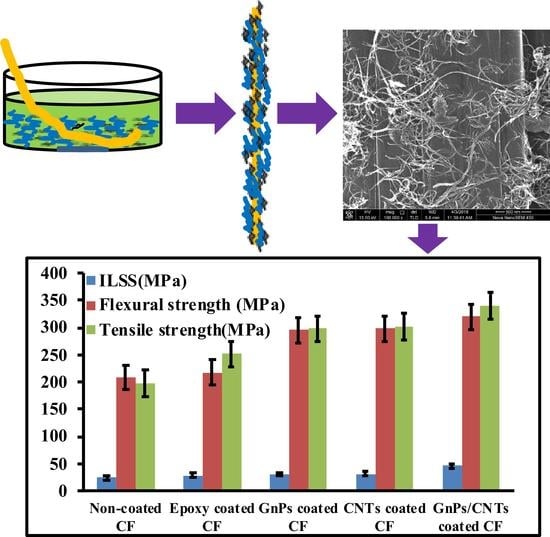Synergistic Effects of Graphene/Carbon Nanotubes Hybrid Coating on the Interfacial and Mechanical Properties of Fiber Composites
Abstract
:1. Introduction
2. Materials and Methods
2.1. Materials
2.2. Preparation of GnPs/CNTs Hybrid Coated CF
2.3. Fabrication of Carbon Fiber Reinforcement Epoxy Composites
2.3.1. Impregnation of CF with Epoxy Resin (Prepreg)
2.3.2. Hot Press Molding Composite Processing
2.4. Characterization
3. Results and Discussion
3.1. Morphology of GnPs/CNTs Hybrid Coated Carbon Fiber
3.2. Monofilament and Multifilament Tensile Strength of GnPs/CNTs Hybrid Coated CF
3.3. Interfacial Property Testing of Carbon Fiber/Epoxy Laminated Composites
3.4. Flexural and Tensile Strength of GnPs/CNTs Hybrid Coated CFRP Composites
3.5. Fractured Surfaces Analysis of CFRP Composites
4. Conclusions
Author Contributions
Funding
Conflicts of Interest
References
- Islam, M.S.; Deng, Y.; Tong, L.; Faisal, S.N.; Roy, A.K.; Minett, A.; Gomes, V.G. Grafting carbon nanotubes directly onto carbon fibers for superior mechanical stability: Towards next generation aerospace composites and energy storage applications. Carbon 2016, 96, 701–710. [Google Scholar] [CrossRef]
- Guermazi, N.; Ben Tarjem, A.; Ksouri, I.; Ayedi, H.F. On the durability of FRP composites for aircraft structures in hygrothermal conditioning. Compos. Part B Eng. 2016, 85, 294–304. [Google Scholar] [CrossRef]
- Kim, K.W.; Kim, D.K.; Kim, B.S.; An, K.-H.; Park, S.-J.; Rhee, K.Y.; Kim, B.-J. Cure behaviors and mechanical properties of carbon fiber-reinforced nylon6/epoxy blended matrix composites. Compos. Part B Eng. 2017, 112, 15–21. [Google Scholar] [CrossRef]
- Sun, T.; Li, M.; Zhou, S.; Liang, M.; Chen, Y.; Zou, H.; Liang, S.Z.M. Multi-scale structure construction of carbon fiber surface by electrophoretic deposition and electropolymerization to enhance the interfacial strength of epoxy resin composites. Appl. Surf. Sci. 2020, 499, 143929. [Google Scholar] [CrossRef]
- Pathak, A.K.; Borah, M.; Gupta, A.; Yokozeki, T.; Dhakate, S.R. Improved mechanical properties of carbon fiber/graphene oxide-epoxy hybrid composites. Compos. Sci. Technol. 2016, 135, 28–38. [Google Scholar] [CrossRef]
- Drzal, L.T.; Madhukar, M. Fibre-matrix adhesion and its relationship to composite mechanical properties. J. Mater. Sci. 1993, 28, 569–610. [Google Scholar] [CrossRef]
- Chen, J.; Wang, K.; Zhao, Y. Enhanced interfacial interactions of carbon fiber reinforced PEEK composites by regulating PEI and graphene oxide complex sizing at the interface. Compos. Sci. Technol. 2018, 154, 175–186. [Google Scholar] [CrossRef]
- Mamalis, D.; Flanagan, T.; O’Brádaigh, C.M. Effect of fibre straightness and sizing in carbon fibre reinforced powder epoxy composites. Compos. Part A Appl. Sci. Manuf. 2018, 110, 93–105. [Google Scholar] [CrossRef]
- Xiong, L.; Zhan, F.; Liang, H.B.; Chen, L.; Lan, D. Chemical grafting of nano-TiO2 onto carbon fibervia thiol-ene click chemistry and its effect on the interfacial and mechanical properties of carbonfiber/epoxy composites. J. Mater. Sci. 2018, 53, 2594–2603. [Google Scholar] [CrossRef]
- Sun, J.; Zhao, F.; Yao, Y.; Jin, Z.; Liu, X.; Huang, Y. High efficient and continuous surface modification of carbon fibers with improved tensile strength and interfacial adhesion. Appl. Surf. Sci. 2017, 412, 424–435. [Google Scholar] [CrossRef]
- Vedrtnam, A. Novel method for improving fatigue behavior of carbon fiber reinforced epoxy composite. Compos. Part B Eng. 2019, 157, 305–321. [Google Scholar] [CrossRef]
- Han, W.; Zhang, H.-P.; Tavakoli, J.; Campbell, J.; Tang, Y. Polydopamine as sizing on carbon fiber surfaces for enhancement of epoxy laminated composites. Compos. Part A Appl. Sci. Manuf. 2018, 107, 626–632. [Google Scholar] [CrossRef] [Green Version]
- Jiang, J.; Yao, X.; Xu, C.; Su, Y.; Zhou, L.; Deng, C. Influence of electrochemical oxidation of carbon fiber on the mechanical properties of carbon fiber/graphene oxide/epoxy composites. Compos. Part A Appl. Sci. Manuf. 2017, 95, 248–256. [Google Scholar] [CrossRef]
- Wang, C.; Li, J.; Yu, J.; Sun, S.; Li, X.; Xie, F.; Jiang, B.; Wu, G.; Yu, F.; Huang, Y. Grafting of size-controlled graphene oxide sheets onto carbon fiber for reinforcement of carbon fiber/epoxy composite interfacial strength. Compos. Part A Appl. Sci. Manuf. 2017, 101, 511–520. [Google Scholar] [CrossRef]
- Ma, K.; Wang, B.; Chen, P.; Zhou, X. Plasma treatment of carbon fibers: Non-equilibrium dynamic adsorption and its effect on the mechanical properties of RTM fabricated composites. Appl. Surf. Sci. 2011, 257, 3824–3830. [Google Scholar] [CrossRef]
- Yuan, J.-M.; Fan, Z.-F.; Yang, Q.-C.; Li, W.; Wu, Z.-J. Surface modification of carbon fibers by microwave etching for epoxy resin composite. Compos. Sci. Technol. 2018, 164, 222–228. [Google Scholar] [CrossRef]
- Tsai, S.-N.; Carolan, D.; Sprenger, S.; Taylor, A.C. Fracture and fatigue behaviour of carbon fibre composites with nanoparticle-sized fibres. Compos. Struct. 2019, 217, 143–149. [Google Scholar] [CrossRef] [Green Version]
- Blackketter, D.M.; Upadhyaya, D.; King, T.R.; King, J.A. Evaluation of fiber surfaces treatment and sizing on the shear and transverse tensile strengths of carbon fiber-reinforced thermoset and thermoplastic matrix composites. Polym. Compos. 1993, 14, 430–436. [Google Scholar] [CrossRef]
- Malekimoghadam, R.; Icardi, U. Prediction of mechanical properties of carbon nanotube‒carbon fiber reinforced hybrid composites using multi-scale finite element modelling. Compos. Part B Eng. 2019, 177, 107405. [Google Scholar] [CrossRef]
- Matveeva, A.Y.; Lomov, S.V.; Gorbatikh, L. Debonding at the fiber/matrix interface in carbon nanotube reinforced T composites: Modelling investigation. Comput. Mater. Sci. 2019, 159, 412–419. [Google Scholar] [CrossRef]
- Qin, W.; Vautard, F.; Drzal, L.T.; Yu, J. Modifying the carbon fiber-epoxy matrix interphase with graphite nanoplatelets. Polym. Compos. 2014, 37, 1549–1556. [Google Scholar] [CrossRef]
- Xiao, C.; Tan, Y.; Wang, X.; Gao, L.; Wang, L.; Qi, Z. Study on interfacial and mechanical improvement of carbon fiber/epoxy composites by depositing multi-walled carbon nanotubes on fibers. Chem. Phys. Lett. 2018, 703, 8–16. [Google Scholar] [CrossRef]
- Kwon, Y.J.; Kim, Y.; Jeon, H.; Cho, S.; Lee, W.; Lee, J.U. Graphene/carbon nanotube hybrid as a multi-functional interfacial reinforcement for carbon fiber-reinforced composites. Compos. Part B Eng. 2017, 122, 23–30. [Google Scholar] [CrossRef]
- Ismail, K.; Sultan, M.T.H.; Shah, A.; Jawaid, M.; Safri, S. Low velocity impact and compression after impact properties of hybrid bio-composites modified with multi-walled carbon nanotubes. Compos. Part B Eng. 2019, 163, 455–463. [Google Scholar] [CrossRef]
- Liang, X.; Cheng, Q. Synergistic reinforcing effect from graphene and carbon nanotubes. Compos. Commun. 2018, 10, 122–128. [Google Scholar] [CrossRef]
- Li, M.; Gu, Y.; Liu, Y.; Li, Y.; Zhang, Z. Interfacial improvement of carbon fiber/epoxy composites using a simple process for depositing commercially functionalized carbon nanotubes on the fibers. Carbon 2013, 52, 109–121. [Google Scholar] [CrossRef]
- Yao, H.; Sui, X.; Zhao, Z.; Xu, Z.; Chen, L.; Deng, H.; Liu, Y.; Qian, X. Optimization of interfacial microstructure and mechanical properties of carbon fiber/epoxy composites via carbon nanotube sizing. Appl. Surf. Sci. 2015, 347, 583–590. [Google Scholar] [CrossRef]
- Li, Y.; Umer, R.; Isakovic, A.; Samad, Y.A.; Zheng, L.; Liao, K. Synergistic toughening of epoxy with carbon nanotubes and graphene oxide for improved long-term performance. RSC Adv. 2013, 3, 8849–8856. [Google Scholar] [CrossRef]
- Su, Y.-N.; Zhang, S.; Zhang, X.-H.; Zhao, Z.-B.; Chen, C.-M.; Jing, D.-Q. Preparation and properties of graphene/carbon fiber/poly(ether ether ketone) composites. Carbon 2017, 124, 723. [Google Scholar] [CrossRef]
- Naveen, J.; Jawaid, M.; Zainudin, E.S.; Sultan, M.T.H.; Yahaya, R. Improved Mechanical and Moisture-Resistant Properties of Woven Hybrid Epoxy Composites by Graphene Nanoplatelets (GNP). Materials 2019, 12, 1249. [Google Scholar] [CrossRef] [Green Version]
- Qin, W.; Vautard, F.; Drzal, L.T.; Yu, J. Mechanical and electrical properties of carbon fiber composites with incorporation of graphene nanoplatelets at the fiber–matrix interphase. Compos. Part B Eng. 2015, 69, 335–341. [Google Scholar] [CrossRef]
- Wang, P.-N.; Hsieh, T.-H.; Chiang, C.-L.; Shen, M.-Y. Synergetic Effects of Mechanical Properties on Graphene Nanoplatelet and Multiwalled Carbon Nanotube Hybrids Reinforced Epoxy/Carbon Fiber Composites. J. Nanomater. 2015, 2015, 1–9. [Google Scholar] [CrossRef]
- Loos, M.; Yang, J.; Feke, D.L.; Manas-Zloczower, I. Effect of block-copolymer dispersants on properties of carbon nanotube/epoxy systems. Compos. Sci. Technol. 2012, 72, 482–488. [Google Scholar] [CrossRef]
- Qi, X.-Y.; Yan, N.; Jiang, Z.; Cao, Y.-K.; Yu, Z.-Z.; Yavari, F.; Koratkar, N. Enhanced Electrical Conductivity in Polystyrene Nanocomposites at Ultra-Low Graphene Content. ACS Appl. Mater. Interfaces 2011, 3, 3130–3133. [Google Scholar] [CrossRef]
- Hung, M.-T.; Choi, O.; Ju, Y.S.; Hahn, H.T. Heat conduction in graphite-nanoplatelet-reinforced polymer nanocomposites. Appl. Phys. Lett. 2006, 89, 23117. [Google Scholar] [CrossRef] [Green Version]
- Worsley, K.A.; Kalinina, I.; Bekyarova, E.; Haddon, R. Functionalization and Dissolution of Nitric Acid Treated Single-Walled Carbon Nanotubes. J. Am. Chem. Soc. 2009, 131, 18153–18158. [Google Scholar] [CrossRef]
- Ladani, R.; Bhasin, M.; Wu, S.; Ravindran, A.R.; Ghorbani, K.; Zhang, J.; Kinloch, A.J.; Mouritz, A.P.; Wang, C.H. Fracture and fatigue behaviour of epoxy nanocomposites containing 1-D and 2-D nanoscale carbon fillers. Eng. Fract. Mech. 2018, 203, 102–114. [Google Scholar] [CrossRef]
- Yue, L.; Pircheraghi, G.; Monemian, S.; Manas-Zloczower, I. Epoxy composites with carbon nanotubes and graphene nanoplatelets—Dispersion and synergy effects. Carbon 2014, 78, 268–278. [Google Scholar] [CrossRef]
- Yang, S.-Y.; Lin, W.-N.; Huang, Y.-L.; Tien, H.-W.; Wang, J.-Y.; Ma, C.-C.M.; Li, S.-M.; Wang, Y.-S. Synergetic effects of graphene platelets and carbon nanotubes on the mechanical and thermal properties of epoxy composites. Carbon 2011, 49, 793–803. [Google Scholar] [CrossRef]
- Yu, A.; Ramesh, P.; Sun, X.; Bekyarova, E.; Itkis, M.E.; Haddon, R. Enhanced Thermal Conductivity in a Hybrid Graphite Nanoplatelet—Carbon Nanotube Filler for Epoxy Composites. Adv. Mater. 2008, 20, 4740–4744. [Google Scholar] [CrossRef]
- Xiong, X.-Q.; Bao, Y.-L.; Liu, H.; Zhu, Q.; Lu, R.; Miyakoshi, T. Study on mechanical and electrical properties of cellulose nanofibrils/graphene-modified natural rubber. Mater. Chem. Phys. 2019, 223, 535–541. [Google Scholar] [CrossRef]
- Carbon Fiber- Determination of the Tensile Properties of Single-Filament Specimens; GB/T 31290-2014; Standardization Adminstration: Beijing, China, 2014.
- Test Methods for Tensile Properties of Carbon Fiber Multifilament; GB/T 3362-2005; Standardization Adminstration: Beijing, China, 2005.
- Test Method for Interlaminar Shear Strength of Unidirectional Fiber-Reinforced Plastics; GB/T 3357-1982; Standardization Adminstration: Beijing, China, 1982.
- Fiber-Reinforced Plastic Composites-Determination of Flexural Properties; GB/T 1449-2005; Standardization Adminstration: Beijing, China, 2005.
- Test Method for Tensile Properties of Orientation Fiber Reinforced Polymer Matrix Composites Materials; GB/T 3354-2014; Standardization Adminstration: Beijing, China, 2014.







| Samples | Monofilament Tensile Strength (GPa) | Relative Increase (%) | Multifilament Tensile Strength (MPa) | Relative Increase (%) |
|---|---|---|---|---|
| Non-coated CF | 2.9 ± 0.2 | - | 1060 ± 90 | - |
| Epoxy coated CF | 3.0 ± 0.4 | 3 | 1100 ± 70 | 4 |
| GnPs coated CF | 3.3 ± 0.1 | 14 | 1810 ± 70 | 71 |
| CNTs coated CF | 3.4 ± 0.1 | 17 | 1820 ± 80 | 72 |
| GnPs/CNTs coated CF | 3.7 ± 0.1 | 28 | 1850 ± 80 | 75 |
| Samples | Flexural Strength (MPa) | Relative Increase (%) | Tensile Strength (MPa) | Relative Increase (%) |
|---|---|---|---|---|
| Non-coated CF | 210 ± 30 | - | 200 ± 30 | - |
| Epoxy coated CF | 220 ± 30 | 5 | 250 ± 30 | 25 |
| GnPs coated CF | 300 ± 30 | 43 | 300 ± 30 | 50 |
| CNTs coated CF | 300 ± 40 | 43 | 300 ± 30 | 50 |
| GnPs/CNTs coated CF | 320 ± 30 | 52 | 340 ± 40 | 70 |
© 2020 by the authors. Licensee MDPI, Basel, Switzerland. This article is an open access article distributed under the terms and conditions of the Creative Commons Attribution (CC BY) license (http://creativecommons.org/licenses/by/4.0/).
Share and Cite
Qin, W.; Chen, C.; Zhou, J.; Meng, J. Synergistic Effects of Graphene/Carbon Nanotubes Hybrid Coating on the Interfacial and Mechanical Properties of Fiber Composites. Materials 2020, 13, 1457. https://doi.org/10.3390/ma13061457
Qin W, Chen C, Zhou J, Meng J. Synergistic Effects of Graphene/Carbon Nanotubes Hybrid Coating on the Interfacial and Mechanical Properties of Fiber Composites. Materials. 2020; 13(6):1457. https://doi.org/10.3390/ma13061457
Chicago/Turabian StyleQin, Wenzhen, Chao Chen, Jianping Zhou, and Jiangyan Meng. 2020. "Synergistic Effects of Graphene/Carbon Nanotubes Hybrid Coating on the Interfacial and Mechanical Properties of Fiber Composites" Materials 13, no. 6: 1457. https://doi.org/10.3390/ma13061457





